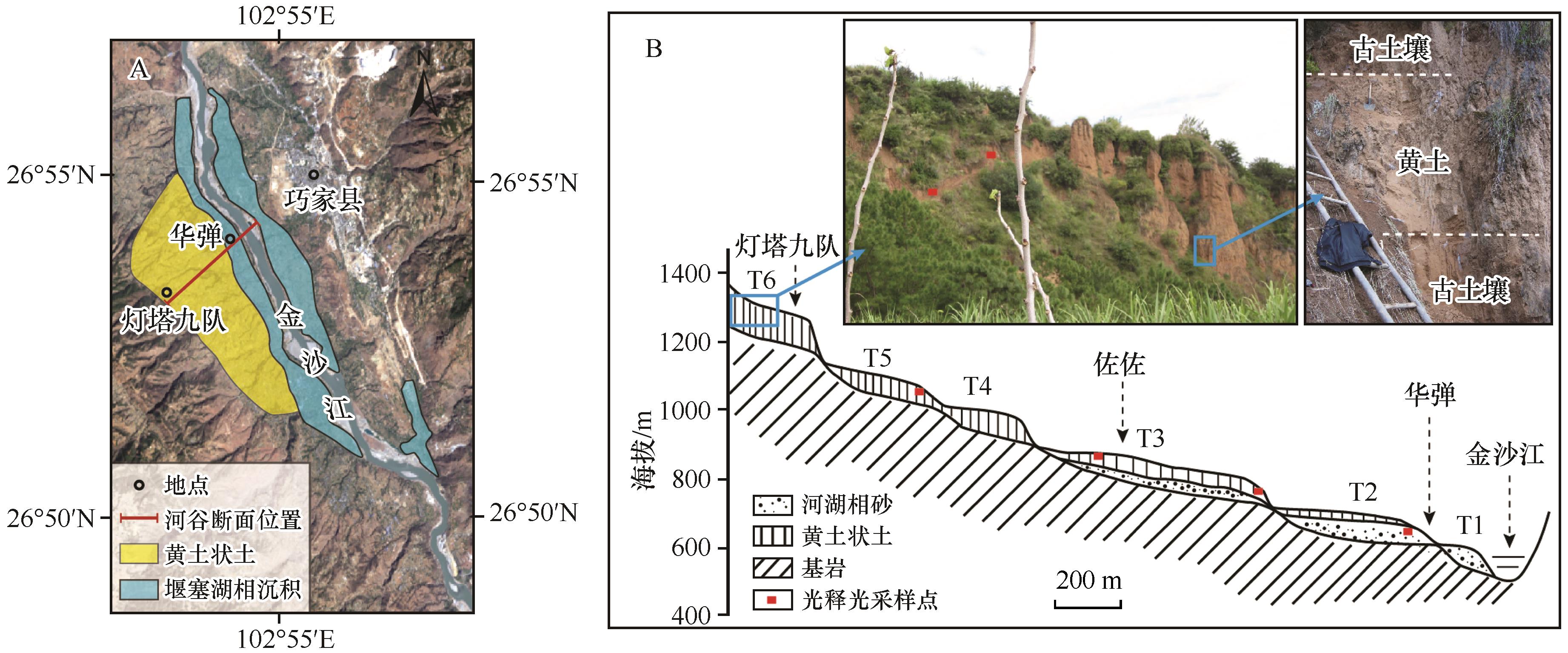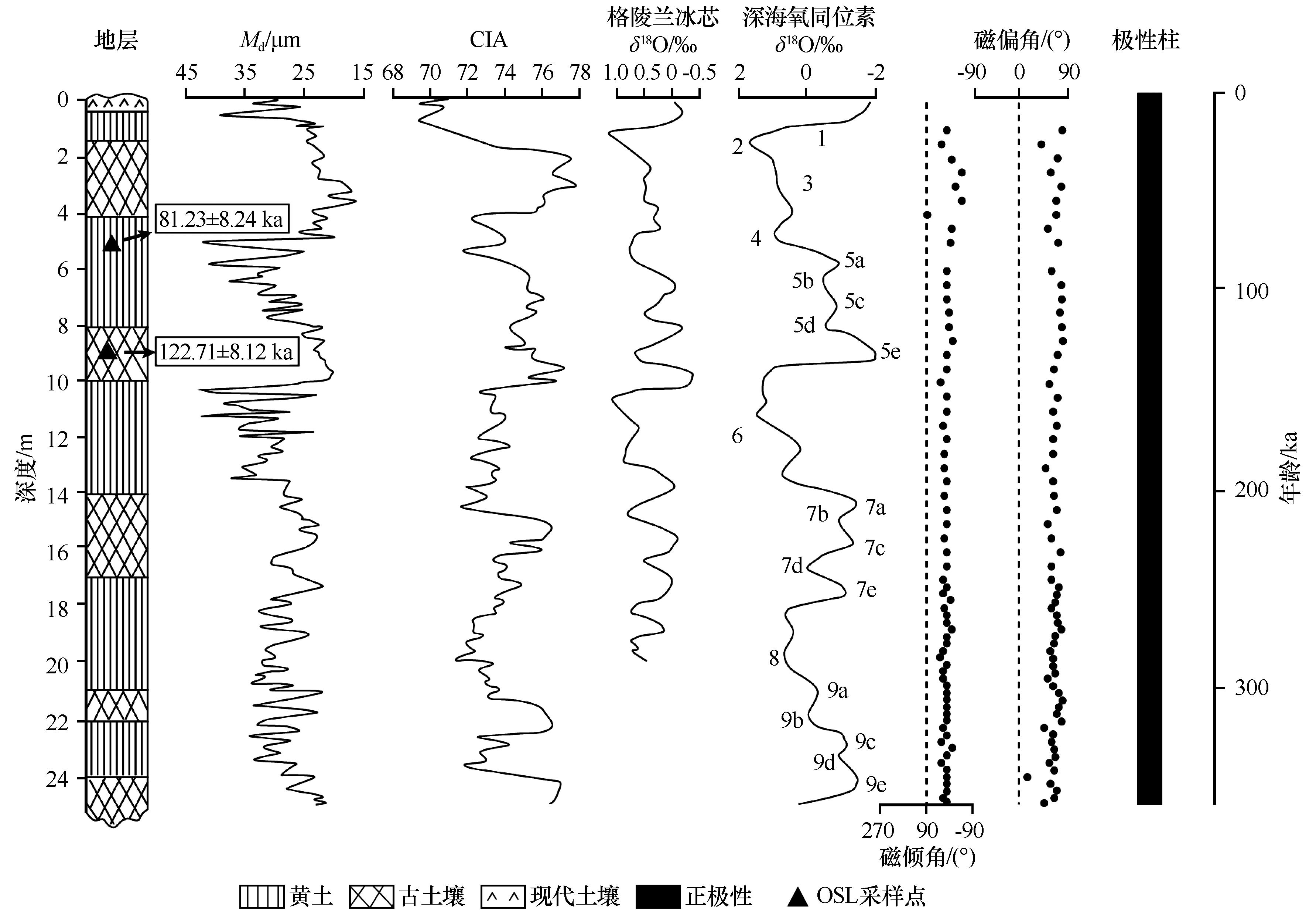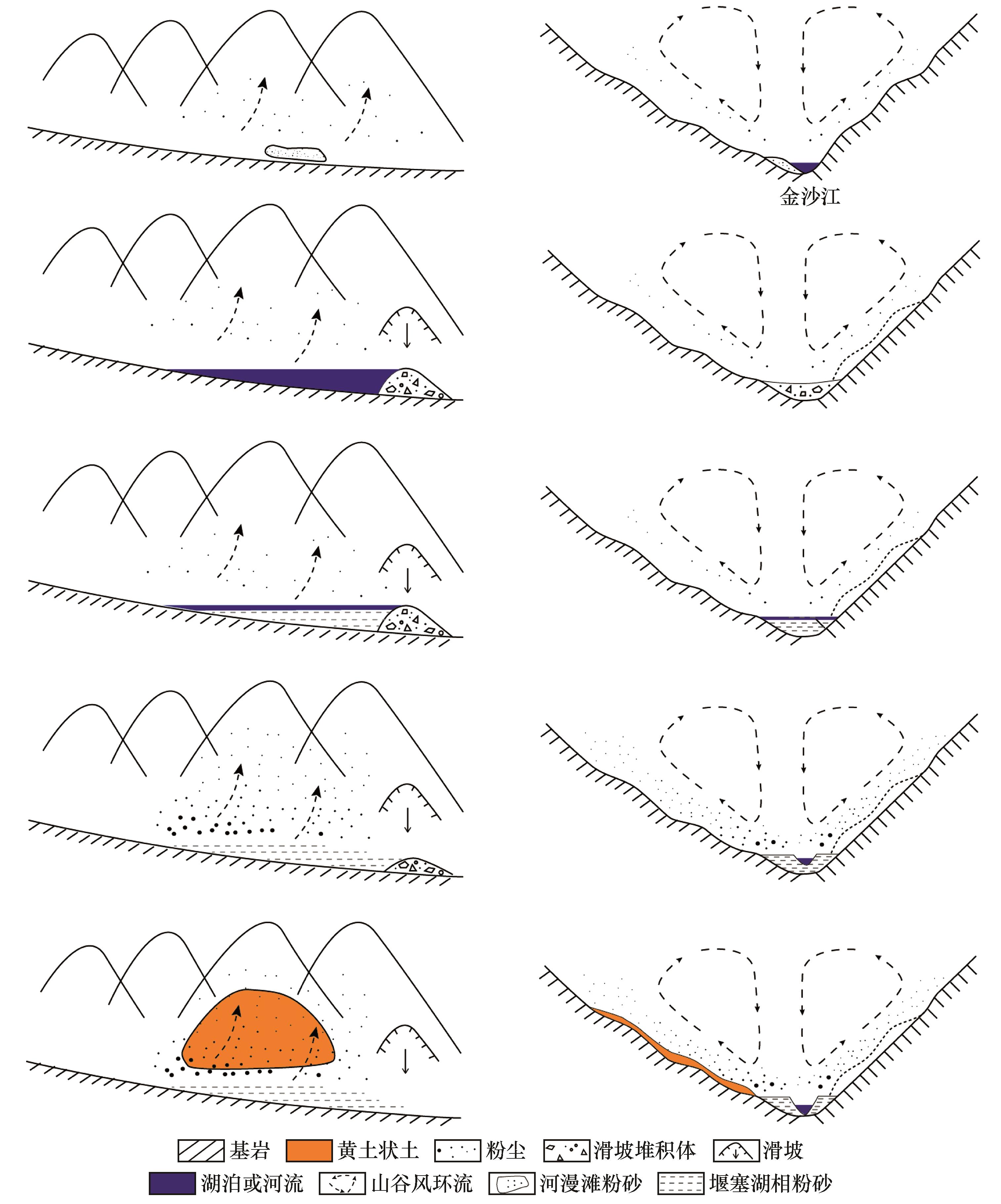
- CN 62-1070/P
- ISSN 1000-694X
- Bimonthly 1981

Journal of Desert Research ›› 2022, Vol. 42 ›› Issue (4): 60-70.DOI: 10.7522/j.issn.1000-694X.2021.00218
Previous Articles Next Articles
Fenliang Liu1( ), Hongshan Gao2, Baotian Pan2, Zongmeng Li3
), Hongshan Gao2, Baotian Pan2, Zongmeng Li3
Received:2021-10-21
Revised:2021-12-08
Online:2022-07-20
Published:2022-08-29
CLC Number:
Fenliang Liu, Hongshan Gao, Baotian Pan, Zongmeng Li. The genesis, age and its paleoclimatic significance of loess-like sediments in the Huatan section of the dry-hot valley of the Jinsha River[J]. Journal of Desert Research, 2022, 42(4): 60-70.
Add to citation manager EndNote|Ris|BibTeX
URL: http://www.desert.ac.cn/EN/10.7522/j.issn.1000-694X.2021.00218

Fig.2 Spatial distribution of loess-like sediments and dammed lake sediments (A) and river terrace and loess profile (B) in the Huatan section of Jinsha River Valley
样品 编号 | 海拔 /m | 深度 /m | K /% | Th /(mg·kg-1) | U /(mg·kg-1) | 含水量 /% | 剂量率 /(Gy·ka-1) | 等效剂量 /Gy | 年代 /ka |
|---|---|---|---|---|---|---|---|---|---|
| Lzu1131 | 665 | 1.2 | 1.57±0.05 | 8.14±0.26 | 2.02±0.08 | 10±5 | 2.73±0.14 | 0.60±0.03 | 0.22±0.02 |
| Lzu1132 | 765 | 2.0 | 1.67±0.05 | 12.2±0.34 | 2.67±0.10 | 10±5 | 3.16±0.17 | 37.48±2.86 | 11.86±1.12 |
| Lzu1133 | 865 | 2.5 | 1.56±0.05 | 12.6±0.35 | 2.92±0.11 | 10±5 | 3.16±0.18 | 65.19±1.61 | 20.67±1.26 |
| Lzu1134 | 1 050 | 5.0 | 1.78±0.06 | 13.4±0.36 | 2.45±0.10 | 10±5 | 3.32±0.18 | 214.25±12.70 | 64.50±5.24 |
| Lzu1135 | 1 355 | 5.0 | 1.89±0.06 | 14.0±0.38 | 2.46±0.10 | 20±5 | 3.06±0.16 | 248.23±21.53 | 81.23±8.24 |
| Lzu1136 | 1 351 | 9.0 | 2.05±0.06 | 13.8±0.37 | 2.85±0.11 | 20±5 | 3.15±0.17 | 386.08±14.68 | 122.71±8.12 |
Table 1 Quartz OSL ages and their related parameters for loess-like sediments samples of the Huatan section of Jinsha River Valley
样品 编号 | 海拔 /m | 深度 /m | K /% | Th /(mg·kg-1) | U /(mg·kg-1) | 含水量 /% | 剂量率 /(Gy·ka-1) | 等效剂量 /Gy | 年代 /ka |
|---|---|---|---|---|---|---|---|---|---|
| Lzu1131 | 665 | 1.2 | 1.57±0.05 | 8.14±0.26 | 2.02±0.08 | 10±5 | 2.73±0.14 | 0.60±0.03 | 0.22±0.02 |
| Lzu1132 | 765 | 2.0 | 1.67±0.05 | 12.2±0.34 | 2.67±0.10 | 10±5 | 3.16±0.17 | 37.48±2.86 | 11.86±1.12 |
| Lzu1133 | 865 | 2.5 | 1.56±0.05 | 12.6±0.35 | 2.92±0.11 | 10±5 | 3.16±0.18 | 65.19±1.61 | 20.67±1.26 |
| Lzu1134 | 1 050 | 5.0 | 1.78±0.06 | 13.4±0.36 | 2.45±0.10 | 10±5 | 3.32±0.18 | 214.25±12.70 | 64.50±5.24 |
| Lzu1135 | 1 355 | 5.0 | 1.89±0.06 | 14.0±0.38 | 2.46±0.10 | 20±5 | 3.06±0.16 | 248.23±21.53 | 81.23±8.24 |
| Lzu1136 | 1 351 | 9.0 | 2.05±0.06 | 13.8±0.37 | 2.85±0.11 | 20±5 | 3.15±0.17 | 386.08±14.68 | 122.71±8.12 |

Fig.4 Measurement results of paleo magnetism, Md curve and CIA curve of loess-like deposit section on sixth terrace of the Huatan section of Jinsha River Valley, compared to the Greenland ice core record and global marine oxygen isotope climate record

Fig.6 The change of mean size, median size (A) and deposition rates (B) of the loess-like sediments with altitude in the Qiaojia section of the Jinsha River Valley

Fig.7 Formation model of the loess-like sediments in the Qiaojia section of the Jinsha River Valley. The left column is the development process of loess-like sediments from the river valley longitudinal section view, and the right is the development process of loess-like sediments from the river valley cross section view
| 1 | 刘东生.黄土与环境[M].北京:科学出版社,1985. |
| 2 | Pye K.The nature,origin and accumulation of loess[J].Quaternary Science Reviews,1995,14:653-667. |
| 3 | 李秉成,孙建中.中国黄土与环境[M].西安:陕西科学技术出版社,2005. |
| 4 | Li Y R, Shi W H, Aydin A,et al.Loess genesis and worldwide distribution[J].Earth-Science Reviews,2020,201:102947. |
| 5 | Fan M, Feng R, Geissman J W,et al.Late Paleogene emergence of a North American loess plateau[J].Geology,2020,48:273-277. |
| 6 | 孙继敏.黄土沉积与地球圈层相互作用[J].第四纪研究,2020,40(1):1-7. |
| 7 | Heller F, Liu T S.Magnetostratigraphical dating of loess deposits in China[J].Nature,1982,300:431-433. |
| 8 | Burbank D W, Li J J.Age and palaeoclimatic significance of the loess of Lanzhou,north China[J].Nature,1985,316:429-431. |
| 9 | Kukla G J, Heller F, Liu X M,et al.Pleistocene climates in China dating by magnetic susceptibility[J].Geology,1988,16:811-814. |
| 10 | An Z S, Kukla G J, Porter S C,et al.Magnetic susceptibility evidence of monsoon variation on the Loess Plateau of central China during the last 130,000 years[J].Quaternary Research,1991,36:29-36. |
| 11 | 鹿化煜,安芷生.洛川黄土地层定年的一个模式及其初步应用[J].沉积学报,1997,15(3):150-152. |
| 12 | Sun J M.Source regions and formation of the loess sediments on the high mountain regions of northwestern China[J].Quaternary Research,2002,58(3):341-351. |
| 13 | Sun J M.Provenance of loess material and formation of loess deposits on the Chinese Loess Plateau[J].Earth and Planetary Science Letters,2002,203:845-859. |
| 14 | Sun Y B, An Z S.Late Pliocene-Pleistocene changes in mass accumulation rates of eolian deposits on the central Chinese Loess Plateau[J].Journal of Geophysical Research,2005,110(D23):D23101. |
| 15 | Pullen A, Kapp P, Mccallister A T,et al.Qaidam Basin and northern Tibetan Plateau as dust sources for the Chinese Loess Plateau and paleoclimatic implications[J].Geology,2011,39(11):1031-1034. |
| 16 | Nie J S, Stevens T, Rittner M,et al.Loess plateau storage of northeastern Tibetan plateau-derived Yellow River sediment[J].Nature Communications,2015,6(1):1-10. |
| 17 | 杨达源.中国东部的第四纪风尘堆积与季风变迁[J].第四纪研究,1991(4):354-360. |
| 18 | Qiao Y S, Guo Z T, Hao Q Z,et al.Loess-soil sequences in southern Anhui Province:magnetostratigraphy and paleoclimatic significance[J].Chinese Science Bulletin,2003,48:2088-2093. |
| 19 | Wang X Y, Lu H Y, Zhang H Z,et al.Distribution,provenance,and onset of the Xiashu Loess in Southeast China with paleoclimatic implications[J].Journal of Asian Earth Sciences,2018,155:180-187. |
| 20 | Li X S, Han Z Y, Lu H Y,et al.Onset of Xiashu loess deposition in southern China by 0.9 Ma and its implications for regional aridification[J].Science China Earth Sciences,2018,61(3):256-269. |
| 21 | Han L, Hao Q, Qiao Y,et al.Geochemical evidence for provenance diversity of loess in southern China and its implications for glacial aridification of the northern subtropical region[J].Quaternary Science Reviews,2019,212:149-163. |
| 22 | Jiang Q D, Hao Q Z, Peng S Z,et al.Grain-size evidence for the transport pathway of the Xiashu loess in northern subtropical China and its linkage with fluvial systems[J].Aeolian Research,2020,46:100613. |
| 23 | 张虎才.武都黄土堆积及晚更新世以来环境变迁研究[J].兰州大学学报(自然科学版),1997,33(1):105-114. |
| 24 | Fang X M, Lü L Q, Yang S L,et al.Loess in Kunlun Mountain and its implications on desert development and Tibetan Plateau uplift in west China[J].Science in China (Series D),2002,45(4):289-299. |
| 25 | Lehmkuhl F, Klinge M, ReesJones J,et al.Late Quaternary aeolian sedimentation in central and south-eastern Tibet[J].Quaternary International,2000,68/71:117-132. |
| 26 | Sun J M, Li S H, Muhs D R,et al.Loess sedimentation in Tibet:provenance,processes,and link with Quaternary glaciations[J].Quaternary Science Reviews,2007,26:2265-2280. |
| 27 | Guan Q Y, Pan B T, Gao H S,et al.Geochemical evidence of the Chinese loess provenance during the Late Pleistocene[J].Palaeogeography,Palaeoclimatology,Palaeoecology,2008,270:53-58. |
| 28 | Lai Z P, Kaiser K, Bruckne H.Luminescence-dated aeolian deposits of late Quaternary age in the southern Tibetan Plateau and their implications for landscape history[J].Quaternary Research,2009,72:421-430. |
| 29 | Guo B, Peng T, Yu H,et al.Magnetostratigraphy and palaeoclimatic significance of the late pliocene red clay:quaternary loess sequence in the Lanzhou Basin,Western Chinese Loess Plateau[J].Geophysical Research Letters,2020,47(3):GL086566. |
| 30 | Li X M, Peng T J, Ma Z H,et al.The sources and transport dynamics of eolian sediments in the NE Tibetan Plateau since 6.7 Ma[J].Geochemistry,Geophysics,Geosystems,2020,21(3):GC008682. |
| 31 | Yang S, Liu L, Chen H,et al.Variability and environmental significance of organic carbon isotopes in Ganzi loess since the last interglacial on the eastern Tibetan Plateau[J].CATENA,2021,196:104866. |
| 32 | 曾方明,薛红盼.青藏高原东北部晚第四纪黄土-古土壤的元素组成及其物源指示[J].中国沙漠,2020,40(6):105-117. |
| 33 | 周笃珺,马海州,高东林,等.青海湖南岸全新世黄土地球化学特征及气候环境意义[J].中国沙漠,2004,24(2):32-36. |
| 34 | 张荣祖.横断山区干旱河谷[M].北京:科学出版社,1992. |
| 35 | 汪阳春,柴宗新,刘淑珍,等.横断山地区的黄土及意义[J].山地学报,1999(4):300-304. |
| 36 | 罗光照,沈林.云南涛源黄土的成因及湿陷性[J].工程勘察,1984(5):14-16. |
| 37 | 蒋复初,吴锡浩,王书兵,等.金沙江巧家段河谷黄土状堆积的时代问题[J].地质力学学报,1999(4):37-42. |
| 38 | 陈杰,史正涛,苏怀,等.巧家盆地黄土的粒度特征及其成因分析[J].云南地理环境研究,2009,21(3):46-52. |
| 39 | 叶玉林,苏怀,董铭,等.元素和矿物组成揭示的金沙江干热河谷黄土状物质的物源[J].地球环境学报,2018,9(3):238-244. |
| 40 | Pan B T, Guan Q Y, Gao H S,et al.The origin and sources of loess-like sediment in the Jinsha River valley,SW China[J].Boreas,2014,43(1):121-131. |
| 41 | Wang H Y, Tong K Y, Hu G,et al.Dam and megafloods at the First Bend of the Yangtze River since the Last Glacial Maximum[J].Geomorphology,2021,373:107491. |
| 42 | 徐则民.金沙江寨子村滑坡坝堰塞湖沉积及其对昔格达组地层成因的启示[J].地质论评,2011(5):69-80. |
| 43 | 刘芬良,高红山,李宗盟,等.金沙江巧家-蒙姑段的阶地发育与河谷地貌演化[J].地理学报,2020,75(5):1095-1105. |
| 44 | 刘芬良,高红山,李宗盟,等.金沙江龙街段晚更新世以来的阶地发育与河谷地貌演化[J].地球科学进展,2020,35(4):431-440. |
| 45 | 孙东怀,鹿化煜, Rea D,等.中国黄土粒度的双峰分布及其古气候意义[J].沉积学报,2000(3):327-335. |
| 46 | Smalley I, O'Hara-Dhand K, Wint J,et al.Rivers and loess:the significance of long river transportation in the complex event-sequence approach to loess deposit formation[J].Quaternary International,2009,198:7-18. |
| 47 | 靳鹤龄,董光荣,张春来.雅鲁藏布江河谷黄土的沉积特征及成因[J].中国沙漠,2000,20(1):15-20. |
| 48 | 刘慧,李晓英,夏翠珍,等.雅鲁藏布江河谷加查-米林段沙丘成因[J].中国沙漠,2020,40(3):16-26. |
| 49 | Dansgaard W, Johnsen S J, Clausen H B,et al.Evidence for general instability of past climate from a 250-kyr ice-core record[J].Nature,1993,364:218-220. |
| 50 | Lisiecki L E, Raymo M E.A Pliocene-Pleistocene stack of 57 globally distributed benthic δ 18O records[J].Paleoceanography,2005,20(1): PA1003. |
| [1] | Wang Le, Yang Liu, Guo Zhihong, Zhang Yubao, Wang Yajun, Yang Guo, Xie Zhongkui. Cloning and Prokaryotic Expression of Pathogenesis-related protein 1 Gene from Oriental Hybrid Lily Sorbonne [J]. Journal of Desert Research, 2018, 38(3): 584-591. |
| [2] | Lu Yue, Zha Xiaochun, Huang Chunchang, Pang Jiangli, Liu Jianfang, Zhang Yuzhu. Pedogenensis Characteristics and Pedogenic Environmental Change of Loess-palaeosol Sequences at Yun County in the Upper Reaches of the Hanjiang River [J]. JOURNAL OF DESERT RESEARCH, 2014, 34(4): 992-997. |
| [3] | MAO Pei-ni, PANG Jiang-li, HUANG Chun-chang, ZHA Xiao-chun, ZHOU Ya-li, HU Ya-wei, ZHENG Shu-wei. Pedogenensis Characteristics and Its Environmental Information Interpretation of Guixianhekou Profile in the Upper Hanjiang River Valley, China [J]. JOURNAL OF DESERT RESEARCH, 2013, 33(6): 1678-1683. |
| [4] | ZHAO Guo-yong1, LIU Xiu-ming 1,2,3, L Bin2, CHEN Qu4, LI Ping-yuan1, GUO Hui1, LIU Zhi1. The Magnetic Susceptibility Enhancement Mechanism of the Red Clay Sequence [J]. JOURNAL OF DESERT RESEARCH, 2013, 33(3): 673-681. |
| [5] | LIU Miao-rong;WANG Gui-yong;LI Sen;LIAO Xiao-xia;LI Zhi-lun. Characteristics and Genesis of Coastal Eolianite and Its Environmental Significance along Hainan Island of China [J]. JOURNAL OF DESERT RESEARCH, 2009, 29(6): 1081-1085. |
| [6] | LIU Xiao\|qiong;ZHAO Jing\|bo;. Environmental Change of Pedogenesis and Sandstorm Activity in the Midwest of Guanzhong Plain during 11500—3100 a BP [J]. JOURNAL OF DESERT RESEARCH, 2007, 27(5): 775-779. |
| [7] | HOU Yan-wei;;WANG Ying-chun;YANG Chi;ZHENG Rong. Morphogenesis and Anatomy of Fissurate Growth of Potaninia Mongolica [J]. JOURNAL OF DESERT RESEARCH, 2006, 26(2): 254-258. |
| [8] | MA Hong, WANG Yan-fei, CAO Rui. Study on Embryology of Haloxylon ammodendron [J]. JOURNAL OF DESERT RESEARCH, 2004, 24(6): 768-772. |
| [9] | LIU Shu-zhen, FAN Jian-rong, LIU Gang-cai. Study of Index System for Land Desertification Assessment in the Dry-hot Valley Area of Jinsha River [J]. JOURNAL OF DESERT RESEARCH, 2002, 22(1): 47-51. |
| [10] | ZHANG Jian-ping, LIU Shu-zhen. A PRELIMINARY STUDY ON LAND DEGRADATION IN PANZHIHUA CITY ON JINSHA RIVER DRY-HOT VALLEY AREA [J]. JOURNAL OF DESERT RESEARCH, 1998, 18(2): 149-153. |
| Viewed | ||||||
|
Full text |
|
|||||
|
Abstract |
|
|||||
©2018Journal of Desert Research
Tel:0931-8267545
Email:caiedit@lzb.ac.cn;desert@lzb.ac.cn
Support:Magtech